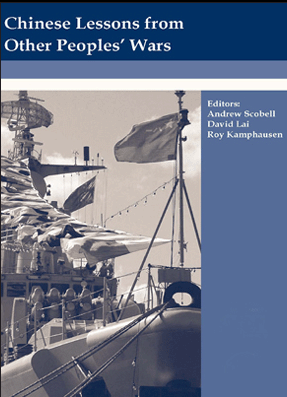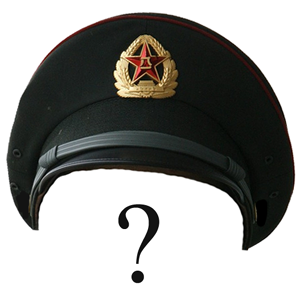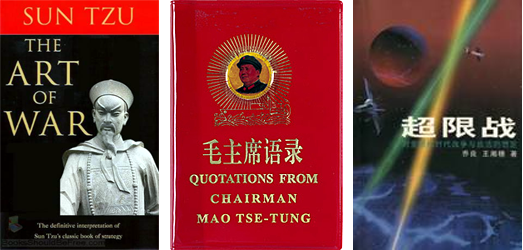Dec 28, 2025
Dec 28, 2025
 Three editors, Mr. Andrew Scobell, Mr. David Lai and Mr. Roy Kamphausen, have collaborated to produce a book, Chinese Lessons from Other Peoples’ Wars brought out in India by Lancer Publishers. To decode the thinking of the People’s Liberation Army (PLA) of China the book has adopted a novel approach. A group of experts after studying the PLA’s reactions to other wars have contributed articles to present their findings. From the PLA’s reactions to other wars the Chinese military’s own approach is sought to be deciphered.
Three editors, Mr. Andrew Scobell, Mr. David Lai and Mr. Roy Kamphausen, have collaborated to produce a book, Chinese Lessons from Other Peoples’ Wars brought out in India by Lancer Publishers. To decode the thinking of the People’s Liberation Army (PLA) of China the book has adopted a novel approach. A group of experts after studying the PLA’s reactions to other wars have contributed articles to present their findings. From the PLA’s reactions to other wars the Chinese military’s own approach is sought to be deciphered.
This approach recalls John Lecarre’s fictional spymaster George Smiley’s first encounter with his fictional Soviet adversary, Karla, temporarily imprisoned in India. Smiley attempts to persuade Karla’s defection. During the interview Karla listens to him intently without uttering a word. But as Smiley urges Karla to consider the future of his wife and family the latter gleans that Smiley’s own family life is dearest to him. After returning to Russia Karla subverts British intelligence to alienate Smiley from his wife. That being Smiley’s vulnerable spot caused destruction of his morale and effectiveness.
The contributors to this book have studied the PLA’s reactions to the wars in Kosovo, Falklands, Iran-Iraq, Gulf and Afghanistan. Each war has a bearing on China’s own situation. For example the Kosovo war was studied by the PLA to better formulate strategy in Tibet and Xingjian. The Falklands war was a model of what might happen against Taiwan aided by the US. The Iran-Iraq war contained lessons on the use of missiles. The Afghan war contains lessons about using air power to augment ground action, and so on.
At the end of it the authors have attempted to draw lessons about what the US might expect in the future from the PLA. The military lessons drawn by the PLA from different wars outlined in the various studies published in the book can be properly assessed only by military and security experts. It would be presumptuous for a layman like this writer to attempt a review of the book. He has never visited China, has no knowledge of military affairs, is ignorant about Chinese history, and does not know Mandarin. However, as an observer of politics and with bits of information gained from here and there, he does have an opinion about the PLA and its future impact on India. For whatever it is worth, it is being shared with readers.
The following facts are worth noting.
China is overwhelmingly a Han country with over 90 percent of its population being Han. Chinese Hans have a strong racist streak and consider themselves on account of their history and culture to be superior to all other people. Not surprisingly they consider themselves most deserving to rule the world. The published views of former General Chi Haotian reflecting the ideals of Nazi Germany may be extreme, but they do reflect the ethos of the Han people. Han society has a strong elitist bias just as Brahmins had in ancient India. The Han elite dominate and exploit the Han peasant. And it is the Han elite that rules present day China. The elite live in the big cities like Shanghai. But even those hailing from rural stock, such as President Hu Jintao and Premier Wen Jiabao, after achieving high office are quickly co-opted in the elite. The children of both leaders have become extraordinarily rich in keeping with current Chinese political practice.
The next key fact to be noted is the prime position of the PLA in China’s political establishment. The Chinese government did not create the PLA. The PLA gave birth to the Chinese government. After ushering the revolution that liberated China the PLA continues to occupy the pre-eminent position in China’s political system. Up till Deng Xiaoping all Chinese leaders participated in Mao’s Long March. Subsequently no Chinese head of the PLA has deigned to serve under either Jiang Zemin or Hu Jintao as Vice-Chairman of the Central Military Commission because neither leader had served in the PLA. It might also be noted that elite Hans as a rule first join the PLA and subsequently join China’s Communist Party as members. The key decisions related to strategy and foreign policies are taken ultimately by the PLA which is known to have sometimes ignored or overruled the government in Beijing. That is why a proper assessment of the PLA’s strategy and intentions is crucial for safeguarding India’s security.
In medieval and modern history the Hans did not acquit themselves too successfully during warfare. For long periods after the 13th century ever since Genghis Khan conquered China and the Mongols led by Kublai Khan ruled China with distinction the domestic Han Chinese suffered foreign rule and humiliation. Indeed the main achievements of China on the seas and in military warfare were brought about by foreigners. The Hans were an introvert people confined within the Great Wall built by them to keep foreigners out. After the Mongols there was an interlude of Han rule under the Ming dynasty. But by the 17th century it was again replaced by the foreign Manchu Qing dynasty which during its tenure conquered Tibet and Xingjian to expand China’s territories.
That is why both Tibetans and Xingjian Uighurs claim independence because they were not part of Han China but of the Manchu empire.
By 1911 the Qing dynasty had decayed and eventually fell to feuding warlords and chaos. In this period European nations enforced unequal treaties with a weakened China, occupied parts of its territories, and indulged in the opium trade. Order and democratic rule was briefly attempted restoration under Sun Yat-sen but that did not last. Eventually the Communists under Mao Zedong conquered China to establish the present government. The defeated remnants of Sun-Yat-sen’s regime established independent rule in Taiwan under the Kuomintang led by Chiang Kai-shek. That briefly is China’s recent history.
 Judging from recent history certain conclusions may be drawn about the PLA’s capabilities and mindset and how these might affect India’s security. Given China’s history, civilization and culture the PLA understandably aims to become the world’s number one superpower. That is unexceptionable. It is the means adopted by it to reach that goal which are questionable. The main PLA target is of course America. The PLA’s temporary impediment is India. Before it can be recognized as the world’s single superpower China must be recognized as Asia’s single regional power. Unlike Japan, India has huge size, large population and second strike nuclear capability. And despite its pathetic performance India has not quite gone under to convince the world that it is totally irrelevant in Asia. And its growing ties with America create the uncomfortable prospect for China that India might never go under. That is why assessing the PLA mindset assumes significance.
Judging from recent history certain conclusions may be drawn about the PLA’s capabilities and mindset and how these might affect India’s security. Given China’s history, civilization and culture the PLA understandably aims to become the world’s number one superpower. That is unexceptionable. It is the means adopted by it to reach that goal which are questionable. The main PLA target is of course America. The PLA’s temporary impediment is India. Before it can be recognized as the world’s single superpower China must be recognized as Asia’s single regional power. Unlike Japan, India has huge size, large population and second strike nuclear capability. And despite its pathetic performance India has not quite gone under to convince the world that it is totally irrelevant in Asia. And its growing ties with America create the uncomfortable prospect for China that India might never go under. That is why assessing the PLA mindset assumes significance.
After assuming power in China the PLA had four military engagements. It participated in the Korean War of 1950-53 in which it expended wave after wave of manpower but showed little professional expertise. It had border skirmishes with Russia on the Sino-Soviet border. It walked over a pathetically unprepared India in the border conflict of 1962 from which military strategists in Beijing could hardly draw real confidence. And finally it had a border war with Vietnam in 1979 in which China got a drubbing. That was the last military engagement of the PLA. There is therefore not much in the record to give confidence of military prowess to PLA generals. Meanwhile Beijing has exponentially increased its defence spending to strengthen its air, naval and ground power to create formidable military strength.
So, how might one assess the potential threat from the PLA?
In this writer’s view Beijing has built strength to deter any fatal attack by achieving the means for a fight to the finish. It is a defensive strategy to prevent unacceptable loss to any army. That does not mean that the PLA is defensive and therefore incapable of aggression. It does mean that while it builds deterrence against possible fatal nuclear attack the PLA is unlikely to engage in conventional wars. The Han military history argues against that. So how might the PLA advance its aggressive strategy? To assess that Han military background needs to be appreciated.

The Bible for China’s military strategists is Sun Tzu who wrote The Art of War in the second century BC. It has been considered the last word on strategy by all Chinese generals and strategists. Mao’s ideas about guerilla warfare were inspired by Sun Tzu and contained in his Little Red Book. The more recent book, Unrestricted Warfare, published by the PLA is also nothing but application of Sun Tzu’s principles of war applied to modern times.
What is the central idea contained in the writings of Sun Tzu?
It would seem that subverting the enemy through secret guile lies at the heart of his strategy. Not for nothing did Sun Tzu advise: “All war is deception.” Or, when he advised: “Be extremely subtle, even to the point of formlessness. Be extremely mysterious, even to the point of soundlessness. Thereby you can be the director of the opponent's fate.” Or, yet again when he advised: “All men can see these tactics whereby I conquer, but what none can see is the strategy out of which victory is evolved.”
Conspiracy and subversion are the PLA’s greatest strength and pose its biggest threat. This approach is rooted in Han history and tradition. Witness the Han tradition of secret societies and its powerful Triads. As Chinese historian Dian Murray has pointed out the Triads were founded “by Chinese patriots in the seventeenth century for the purpose of overthrowing the Qing (Manchu) dynasty and restoring the Ming (Chinese). This view was put forward by Sun Yat-sen and other revolutionaries who claimed that, like the anti-Manchu founders of the Tiandihui (Triads), their goal was to strip the Manchus of their throne. The Chinese Nationalists (Kuomintang) today claim the Triads as part of their heritage.” Even today, Triads connect overseas Chinese to mainland China.
To counter the US the PLA would rely on subversion in which it has already made substantial headway. For inflicting military damage it would utilize Islamist terror groups it has effectively penetrated, aided and controlled. Islamist outfits are the cannon fodder that can be used by the PLA to paralyze the west. Specifically for India also the threat of an all out war launched by the PLA is remote because that could invite global intervention. For direct military intervention the PLA would most likely rely on a short sharp clash after finding a weak spot for quick victory and huge psychological gain. For the rest, the PLA would rely most on what it knows best – subversion. For any major military attack the PLA would not engage directly but utilize any one of the several proxy armies or groups it has nurtured. Subversion remains the PLA’s most lethal weapon as is testified by the contents of Unrestricted Warfare.
Sun Tzu wrote: “Supreme excellence consists in breaking the enemy's resistance without fighting.”
28-Aug-2012
More by : Dr. Rajinder Puri

|
I am trying again Narendra Modi is doing mostly what Sun Tzu wrote. |